Sticker albums are a staple of many a childhood and they were certainly a part of mine. However, unlike my school contemporaries in the early 1990s, I didn’t deal with stickers of footballers or garbage pail kids, all my swapsies were dinosaur stickers of course! And the toys that came with them…

Panini’s Prehistoric Animals sticker album has been published in several editions over the decades going back to the 1970s. Some versions had greater or smaller numbers of stickers, some had slightly different titles, and they were published in a variety of languages, but all of the stickers featured the same spectacular palaeoart by Andrew W. Allen (mostly ‘inspired’ by earlier artists such as Knight and Burian). See, for example, Love in the Time’s review of the 1980s version of this sticker book. I vaguely recall having the 1980s edition as well (whatever happened to it I don’t know), but the version I’m most familiar with is the 1992 edition, which I still own today. I went a long way to completing it, too, but not far enough – I never did complete my album, although I did deface its front cover with spare stickers.
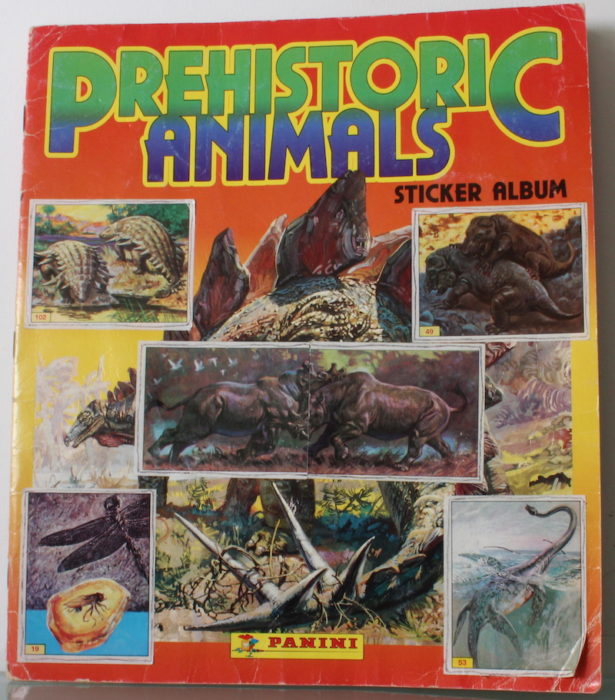
Album and artwork aside, in the 1990s each pack of stickers came in a blind bag with a small dinosaur toy. Twelve-year-old me couldn’t get enough of these, and old habits die hard, as 38-year-old me can’t get enough of them either. We’ve already discussed these miniature models in some detail on the Dinosaur Toy Forum, but they really deserve some attention here on the Dinotoyblog as well. I’m calling the set “Prehistoric Animals” after the title of the 1992 sticker album, and I’m attributing them to Panini for the same reason, but they don’t have an official name and I don’t know the manufacturer.
Panini did not provide a checklist, but the rear cover of the album shows the whole set (not quite, actually, see below) neatly arranged on a fold out cardboard landscape. This landscape came free with the sticker album and I still have my playset, which makes for a pleasing little diorama divided into four platforms. The bottom platform is the ocean, while an exploding volcano is located at the top of the display. Rocks and trees pop up on the front edge of each platform, which look lovely, but leave perilous tree-shaped and rock-shaped openings behind them. I taped over them when I was a kid to stop the dinosaurs falling through. I also ticked off the figures on the back cover as I added them to my collection.

Now, onto the figures themselves. I toyed (pff!) with reviewing these individually but concluded that they really belong together as a family. So, this is going to be a long review, in two parts, as we inspect every one of the 24 miniature creatures in this magnificent set. Each toy is embossed on the underside with the animal name, series number (1-24), and the word “CHINA”. I’ll treat them briefly in number order, starting with the first 12.
Number 1 is the crested Corythosaurus. It is rearing up in a tail-dragging tripod pose and it has bunny hands. Many of the dinosaurs in this line do. It has warty-looking raised bumps on its brown skin. Simply put, this is an outdated restoration, but that’ll be a recurring theme! All of the figures are basically dichrome with a single flat colour on top that fades into a paler colour (unpainted bare plastic) below. The toys come in one of five colours: brown, purple, orange, green, and beige. The eyes are always picked out with a black dot.
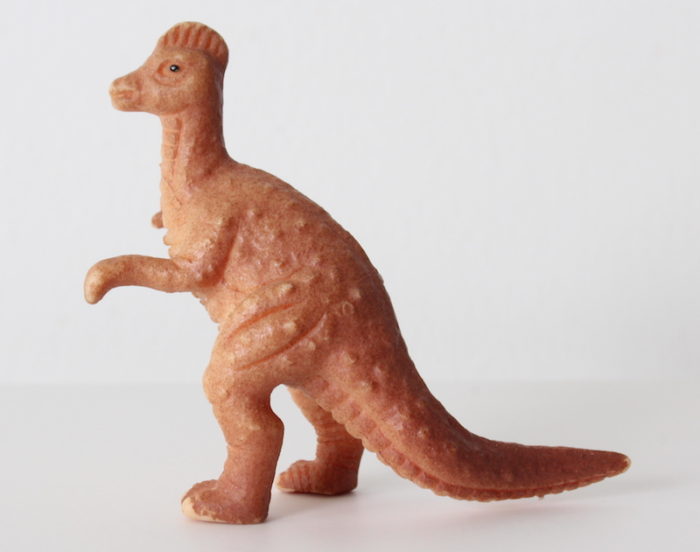
Number 2 is Ankylosaurus. The end of the tail is notable for its unusual shape, which looks more like a rattlesnake’s tail than a bony club. It has an old fashioned arrangement of armour: a mesh of neatly arranged flat plates on the top, flanked either side by a row of triangular spikes. Let’s be fair, that’s what all ankylosaurids looked like in 1992. Indeed, there’s another one just like it in this set. For some reason, Ankylosaurus doesn’t make an appearance in the album, one of several species that are represented by 1992 Panini toys but not stickers. Odd.
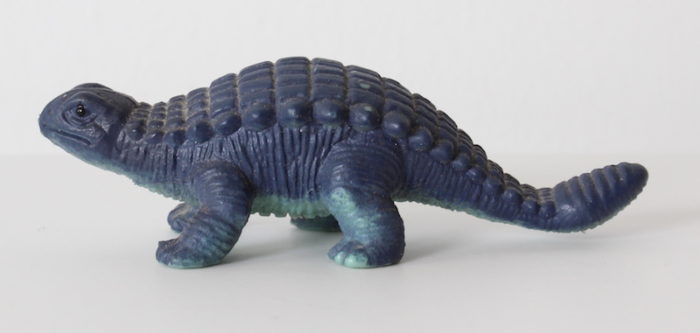
Number 3 is a Pteranodon, the only pterosaur in the set. It stands precariously on two hind feet with its arms outstretched in apparent anticipation of a hug. That embrace may not be forthcoming, for its wing membranes are embellished with a network of unattractive bulging blood vessels. At least the overall anatomy of the wings is pterosaur-like rather than bat-like. This is one of the more wooden-looking figures in the set, partly because of its impossible posture. A quick aside, I seem to have misplaced my Panini version of this figure, so the one in the photo is a slightly smaller non-Panini variant. There will be more about variants in part 2.
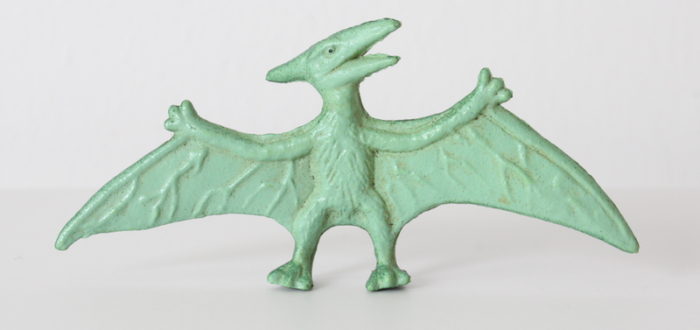
Number 4 is Tyrannosaurus. It is rearing up into an almost vertical posture. Its arms are huge, for a Tyrannosaurus anyway, and raised up unusually high. It has the correct number of fingers, though. The head is noteworthy because it has lips which hide its teeth. Tyrannosaurus toys don’t usually appear this calm. A row of low spines run along the midline from the top of the head to the tip of the tail. The bright orange colour doesn’t do it any favours.
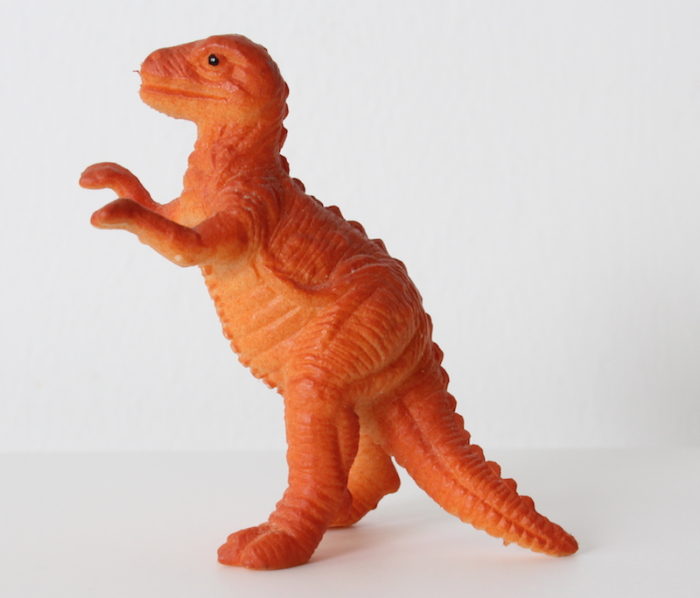
Number 5 is a purple Stegosaurus. The deeply wrinkled skin is representative of many of the dinosaurs in this set, which seem to have spent too much time bathing in a water hole. The plates are unusually angular, almost perfect diamonds, with vertical ridges that bare no relationship to the actual fossil material. The double-row of plates is also rather widely spaced so a flat platform runs between them. The thagomizer has the correct number of spikes.
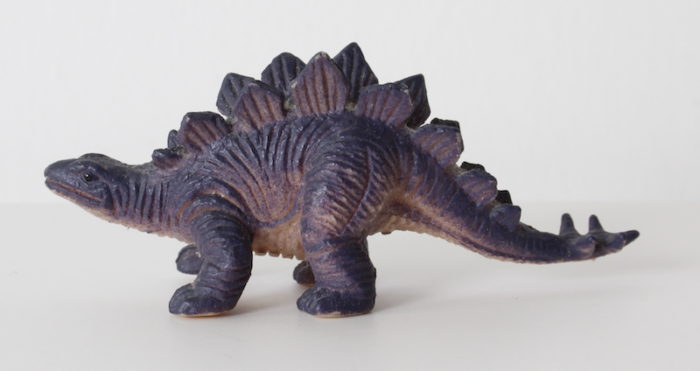
Number 6 is Camptosaurus. This is a pleasant addition because this genus is represented by very few toys. Its pointy head is reminiscent of a duck-billed dinosaur, which Camptosaurus was not, but maybe that’s the look they were going for. Maybe they even misnamed it. As usual for ‘bipedal’ dinosaur toys of this period, it’s dragging its tail in a tripod pose. The arms in this toy hang down more naturally than the other rearing dinosaurs in this series, so it has that going for it. Again, it is unusual to see this dinosaur in the series because it isn’t featured anywhere in the 1992 Panini sticker book.
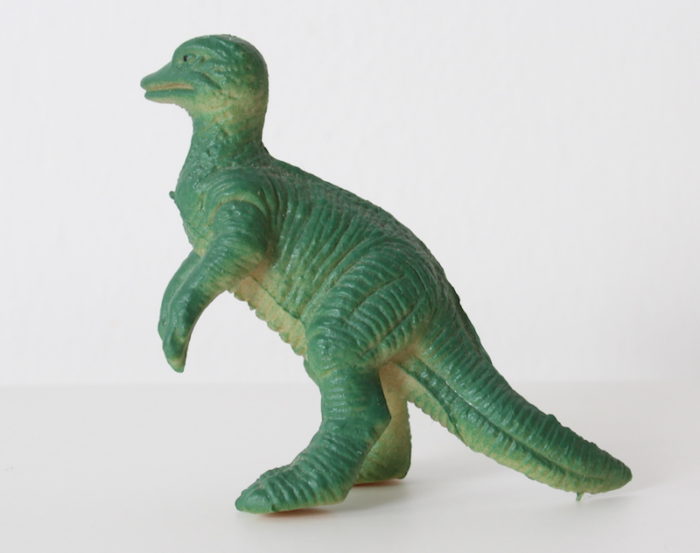
Number 7 is a magnificent Iguanodon giving us the thumbs up. This one has bumpy skin (like the Corythosaurus) rather than wrinkled skin. It has a flappy dewlap on its neck and low spines running down its back, both reminiscent of the Invicta version of this dinosaur, itself inspired by paleo-art by Burian. I think it is a safe bet the sculptor was referring to Burian’s restorations. Again, Iguanodon is perplexingly absent from the sticker album, but this toy is one of my favourites in the Panini series.
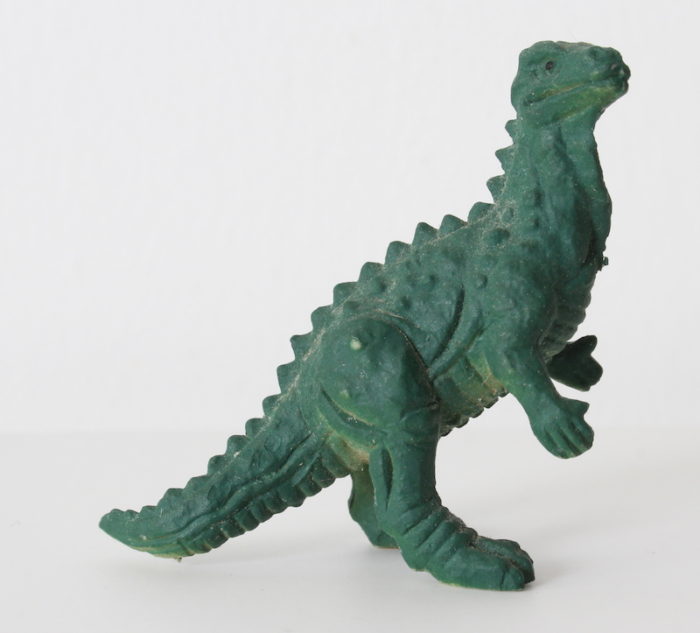
Number 8 is Brontosaurus. A few years ago we might’ve presumed they meant Apatosaurus, but Brontosaurus is valid again now, so let’s go with that. This is another one of the unflatteringly orange figures. It is twisting its neck to look behind it, but the head is lacking in details. The legs are rather stumpy, an affliction most of the quadrupedal dinosaurs in this line suffer from. The tail is actually almost vertical and doesn’t touch the ground.
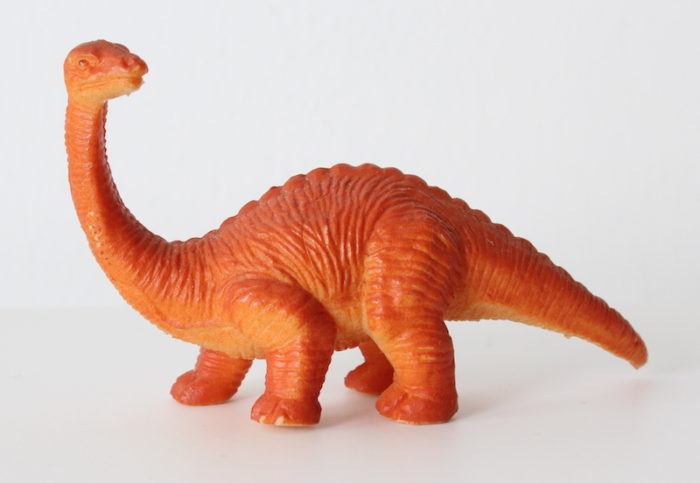
Number 9 is Protoceratops. This sandy-brown individual has a rather miserable expression. Otherwise, it is an unremarkable figure. It has incredibly squat legs, but not as squat as the other ceratopsian in the set…
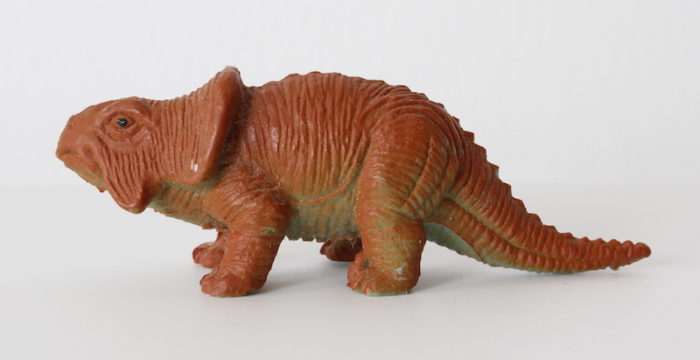
Number 10 is the most squat Triceratops you ever will see. Its truncated legs barely keep it from dragging its belly on the ground. The tail is also unusually long in this toy. Despite the unusual proportions of the body, the head is rather good. The three horns are correctly positioned and an array of triangular prongs (the epiparietals) adorn the rim of the frill.
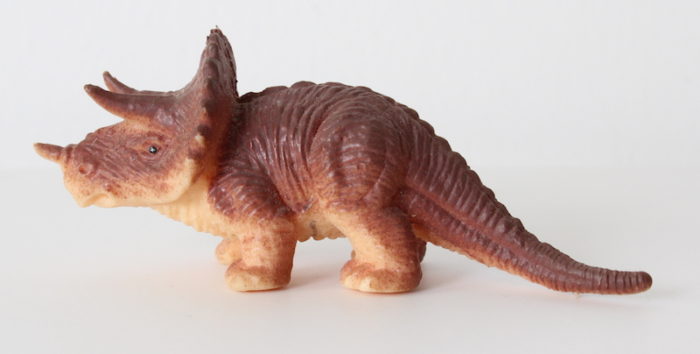
Number 11 is Parasaurolophus. Like all of the ornithopods in this set, the Parasaurolophus is posed bolt upright. The body is almost identical to the Corythosaurus but has a different texture. The tubular crest is rather short, suggesting that this is a female. Naturally, the mouth is expanded into a duck-like bill. From the pose of the hands I guess it is missing a piano.
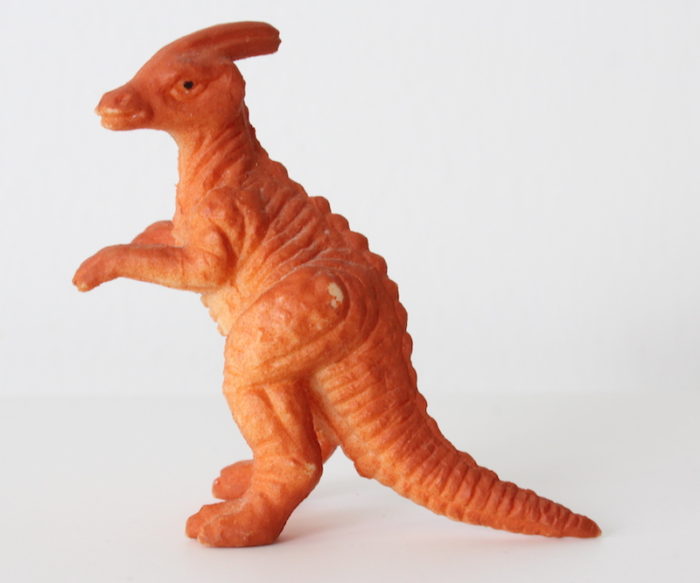
Number 12 is Dimetrodon. I never realised this figure existed as a kid because it is missing from the group photograph on the rear cover of the album (see above). It must’ve been hiding behind a tree. DTF member Roselaar was kindly able to equip me with one so I could finally complete my collection, 25 years after initiating it. The Dimetrodon has long and widely sprawling legs, and a generic head that looks nothing like a Dimetrodon. This toy looks more like those lizards with frills and spikes glued onto them in old dinosaur movies. This figure doesn’t seem to be inspired by any paleoart I recognise.

And that’s 12 down, 12 to go. Stay tuned for part 2 of this review, in which I will consider the remaining toys: three more dinosaurs (four if you include birds), marine reptiles and prehistoric mammals. We will also discover that Panini were not the only company to distribute these little figures.
Go to part 2.
Disclaimer: links to Ebay and Amazon on the DinoToyBlog are affiliate links, so we make a small commission if you use them. Thanks for supporting us!




hello, I’m throwing a bottle in the sea. I’m looking for a copy or a scan of the cardboard stand from panini for the mini figurines “prehistoric animals panini” would someone do that? thank you so much.
Did you find a good scan? I am thinking of just painting a display stand i got from aliexpress
I had the figures and the playset when I was little. I enjoyed the playset! I found the figures quite boring though, and it’s only recently that I’ve realised why. Diversity isn’t represented well enough among these figures!
This set includes two nearly identical ankylosaurids (and three ankylosaurs in total), four ornithopods – two of which are hadrosaurs – and two non-hadrosaurs which are fairly similar, and two ceratopsians. Yet it only contains one Mesozoic theropod, Tyrannosaurus! There are too many similar herbivorous dinosaurs in this set, and nowhere near enough carnivorous dinosaurs. For me, this really limited how this set could be played with, which was made worse by the fact I’ve never found Tyrannosaurus a particularly interesting animal.
I’m sure I would’ve enjoyed this set more if it included figures of different types of theropods, instead of one of the ankylosaurids, one of the hadrosaurs, one of the non-hadrosaur ornithopods, and Dimetrodon as well since it lived in a completely different era to all the other animals in this set. If that had been done, this set would still have twice as many ornithischians as the number of theropods…
@Sim. I understand. But on the other hand, there are three marine reptiles, four prehistoric mammals, a bird (technically a theropod) in the set. It is quite diverse in that regard.
The last sentence in my previous comment is incorrect, it should say: “If that had been done, this set would still have more ornithischians than theropods…” I don’t know how I managed to get that wrong. Maybe the clocks changing did something to me yesterday…
I actually quite liked the Mesozoic marine life figures in this set. The diversity in the three marine reptile figures made them fun to use together, and possibilities could be increased by using the Pteranodon with them as well.
Nice review. The figures themselves have a very cute, retro look. That triceratops must have been based on a Russian genus, how else can you explain that level of squat?